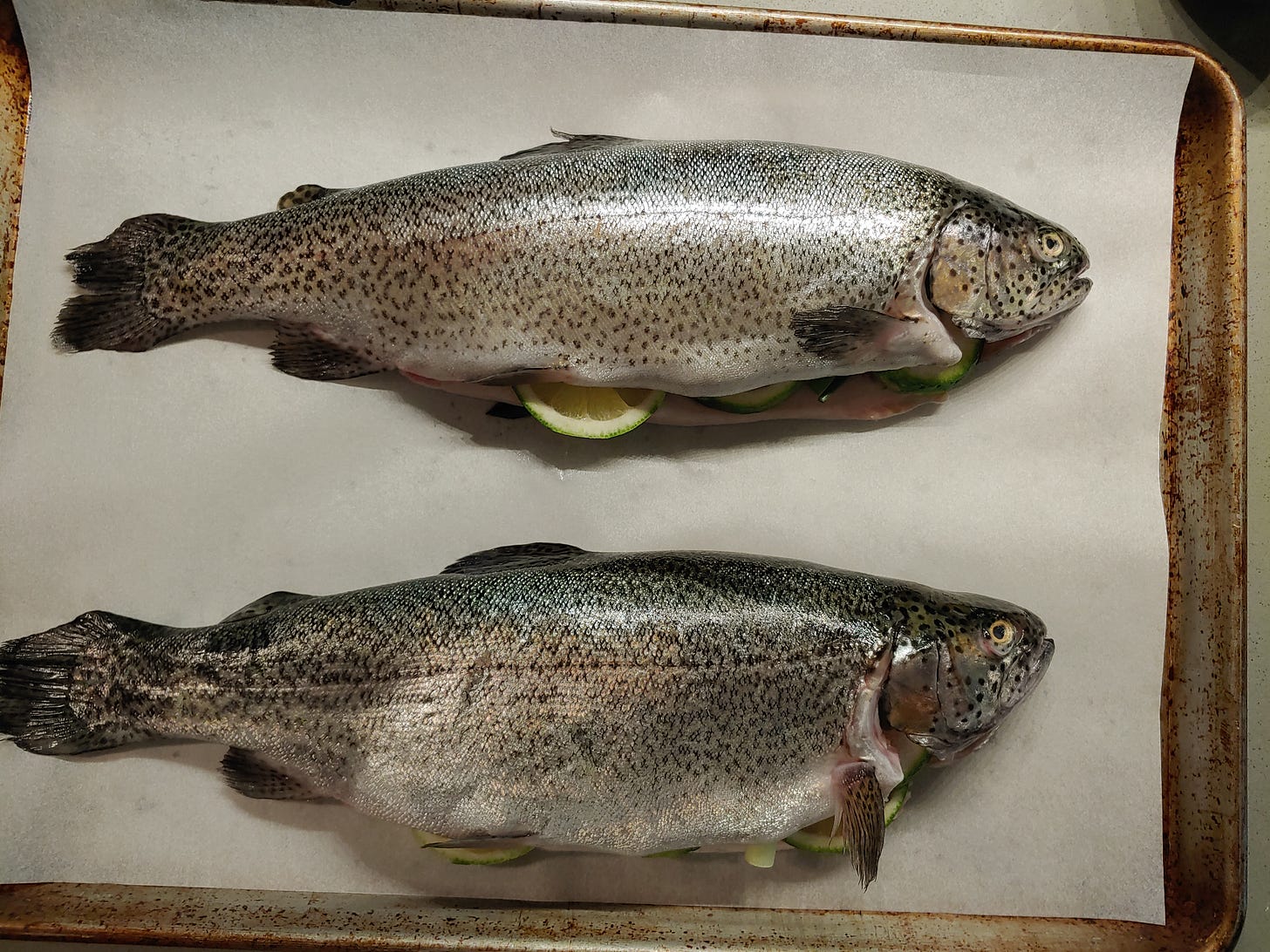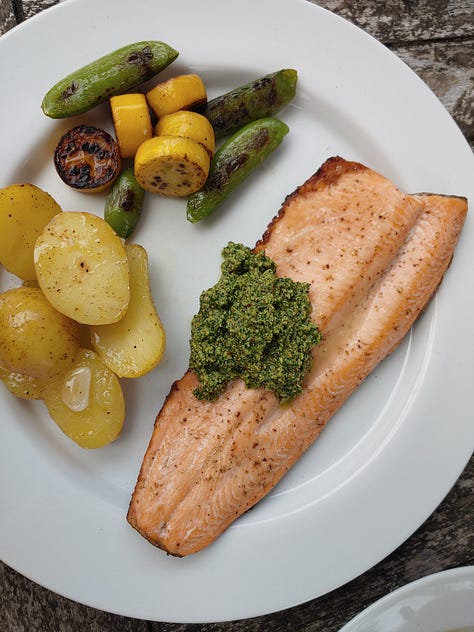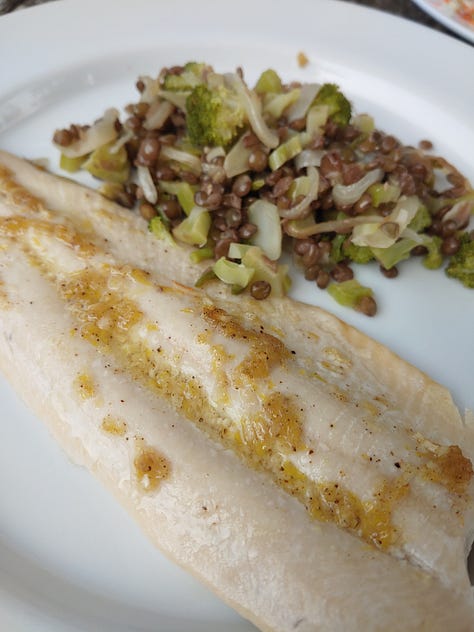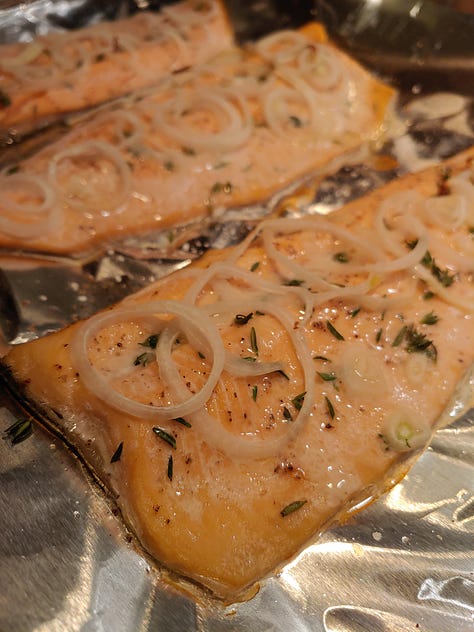Contemplating Trout
And wondering why this versatile, mild fish doesn’t get cooked more often, plus a couple recipes of course!
A quick note before getting to trout. I wasn’t able to get a video showing how I fold parchment paper packets in the last issue before sending it out—but I have since added a video to that post. So you can go have a look at that if you’d like.
After returning from my trip to Idaho in January, my great dinner at Enoteca in Ketchum lingered on my mind for a few days. The entrée of Parmesan and panko crusted trout I chose that night was so good, it had me and my dinner companion chatting about trout for a while, wondering why it’s not more popular—both on restaurant menus and in home kitchens. I find it perplexing that such a versatile, easy-to-cook, mild-flavored, and perfect-portion-sized fish doesn’t garner more attention.
I’ve been a fan of trout for many years. Among projects I did for Cooking Light magazine a while back was one to develop seven trout recipes for an article, which ended up including baked trout with an olive-tomato relish and grilled trout with rosemary and garlic. One of the recipes I share below is based on another recipe from that article. And back even further to my Simply Seafood magazine days, trout was in regular rotation there too.

In the midst of my recent contemplations of trout, I posted a question on Facebook to get a sense of how at least some of my friends feel about the fish, if they can easily find it, maybe even cook it occasionally.
This very informal query brought up some interesting perspectives. I’ll be curious if you relate to some of this feedback or have other thoughts to add about trout (if so, hop down the page to the comments section to let me know!).
one particularly enthusiastic response was from a culinary professional friend in Atlanta who said she can easily get both whole trout and boneless fillets, and cooks trout often both for herself and her clients
a few folks mentioned seeing primarily whole trout available near them, some saying how great trout are to cook whole; others noted that they ask to have the trout filleted at the seafood counter. (When I called 8 or 10 stores around the country to ask what trout they had available, some mentioned that they only carry whole but that they’re happy to fillet the fish for a customer; keep that in mind as an option).
for some, the pesky pin-bones running through the fillets are a key turn-off with trout (see below about boneless becoming more available); I encouraged one friend who hasn’t cooked trout in 30 years because of it to keep an eye out for those boneless fillets.
one mentioned that the trout he sees frequently in his neighborhood store is farm-raised (as is most, if not all, of what’s sold in stores), “so I always wonder about that…,” he said. My reply to him: “U.S. farmed trout made Seafood Watch's top-ten list of what they called "Super Green" options, the "no-brainers." And Riverence, which is the largest producer in the U.S. (and I visited a couple of their farms a couple of years ago) is also certified by the Aquaculture Stewardship Council. Trout's a great option.”
About those bones: the good news is that fillets with pin bones removed are available, and hopefully will be more broadly so soon. A couple of summers ago I had the chance to visit two Riverence trout farms in the Snake River Valley in southern Idaho, some highlights of which I included in this previous issue. They generously sent me some of their trout fillets after I got home, all of which were delightfully pin-bone-free, making them the breeziest of dinner options. They have packages of frozen trout fillets starting to make appearances in stores around the U.S., I’ll be keeping an eye out for them in the Seattle area.
Other perspective I have about public interest in trout is based on a seafood shopping survey I conducted a couple of years ago. One of the questions I posed on that survey was “What are the top 3 to 5 types of seafood you most often cook at home?” I didn’t give a list for respondents to choose from, instead there was a text box for them to write in their answer.
After tallying the responses, I found that trout was mentioned only 4 times from among the 100 or so surveys. For comparison, the top responses on that survey were salmon with 93 mentions, shrimp with 78, crab with 52, clams and halibut both with 40, followed by scallops (28), oysters (27), mussels (27), and cod (25).
I love all those seafoods too!! I’m just surprised that trout hasn’t yet worked its way up the list of popular seafood options—at least here in the United States. The National Fisheries Institute puts out a Top Ten list of seafoods every year, and I may not have seen every one of those lists in the past couple decades but don’t recall trout ever breaking into that top ten.
To help inspire a bit more trout cooking at home, here are two recipes below. And here’s a link to one I included a couple summers ago, during grilling season: Grilled Trout with Herb-Green Olive Salad.



Hazelnut-Crusted Trout
Based on one of the recipes I wrote for that Cooking Light article years back, trout fillets are topped with a mixture of nuts, cheese, herbs, and citrus before baking. With plenty of options among those categories of ingredients, this delightfully easy recipe has plenty of room to mix things up. And you can certainly use just 2 or 3 of the elements, as so inspired. Here I give it a go with hazelnuts, Parmesan, lemon, and thyme. We’re two for dinner at my house most nights, so I halved the recipe when I recently cooked this, and you certainly can too.
If you want skinless fillets for serving, you don’t have to bother with skinning fillets in advance when baking them as for this recipe. Instead, lay them skin-down on a piece of un-oiled foil. After baking, slip your spatula between flesh and skin, leaving the skin stuck to the foil: you get a skinless fillet to serve and easy clean-up. It’s a great time to use a fish spatula, of which I sung praises in this earlier newsletter.
1/4 cup finely chopped, toasted hazelnuts
1/4 cup panko or regular bread crumbs
1/4 cup finely grated Parmesan cheese
1 teaspoon finely grated lemon zest
1/2 teaspoon minced fresh thyme
Kosher salt and freshly ground black pepper
4 trout fillets, about 6 ounces each
Lemon wedges, for serving
Preheat the oven to 400 F. Line a rimmed baking sheet with foil.
Stir together the hazelnuts, bread crumbs, cheese, lemon zest, and thyme, with a good pinch each of salt and pepper, in a small bowl. Lay the trout fillets skin side down on the foil-lined baking sheet and sprinkle the hazelnut mixture evenly over. Bake until the topping is lightly browned and the trout is opaque through the thickest part, 8 to 10 minutes.
Slide a long spatula between the skin and flesh to transfer the trout fillets to individual plates. Serve with lemon wedges alongside for squeezing.
Makes 4 servings
Baked Whole Trout with Ginger and Lime
This is a recipe I taught last summer in a class called Fish Four Ways, focusing on four different cooking techniques. A small rainbow trout is a great way to play around with, and get comfortable with, cooking fish whole. Baking and grilling are prime techniques for whole fish, both allow for easy accommodation of their various sizes and shapes. When grilling, you can cook the fish as is, directly on the grill grate, or lay it on a piece of foil, making it a bit easier to move to and from the grill. Depending on the size of the fish and the appetite of those eating, each fish can serve one or two people.
2 small whole rainbow trout (about 1 pound each)
2-inch piece ginger root, peeled
1 lime
4 green onions, trimmed
2 tablespoons olive oil
Kosher salt and freshly ground black pepper
Rinse the trout inside and out and dry well with paper towels. Preheat the oven to 400°F and line a baking sheet with parchment paper or foil.
Finely grate enough of the ginger to measure 1 teaspoon and put that in a small bowl. Thinly slice the remaining ginger.
Grate enough zest from the lime to measure 1 teaspoon and add it to the bowl with the ginger. Thinly slice the rest of the lime.
Mince enough of the green onion to measure 2 teaspoons and add it to the bowl. Cut the remaining green onions into 2-inch lengths.
Add the olive oil and a good pinch each of salt and pepper to the bowl and stir to mix. Rub the oil mixture over both sides of the trout and arrange them on the baking sheet. Evenly distribute the pieces of ginger, lime, and green onion among the cavities of the trout. Sprinkle a bit more salt on the surface and in the cavity of each fish.
Bake the trout until the flesh is opaque through the thickest part, 18 to 22 minutes.
Use 2 spatulas (fish spatulas are great for this) to carefully transfer the trout to individual plates. Or for 4 servings, fillet the fish before plating.
Makes 2 to 4 servings




Great post! I do mine with a nice vinaigrette and especially love it in asparagus season. I think with increasing concerns over pollutants in freshwater fish, we will see more farmed trout where conditions are controlled.